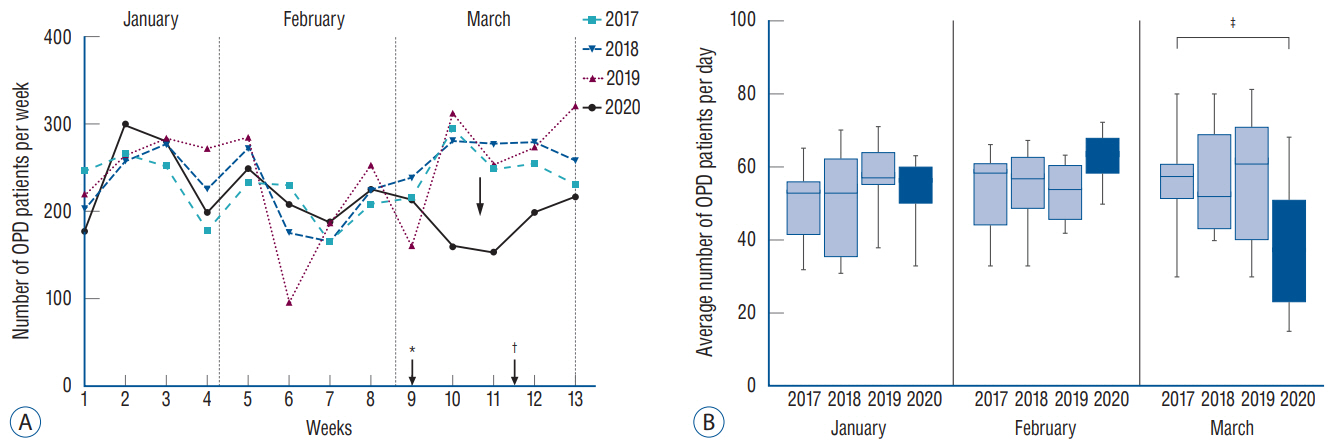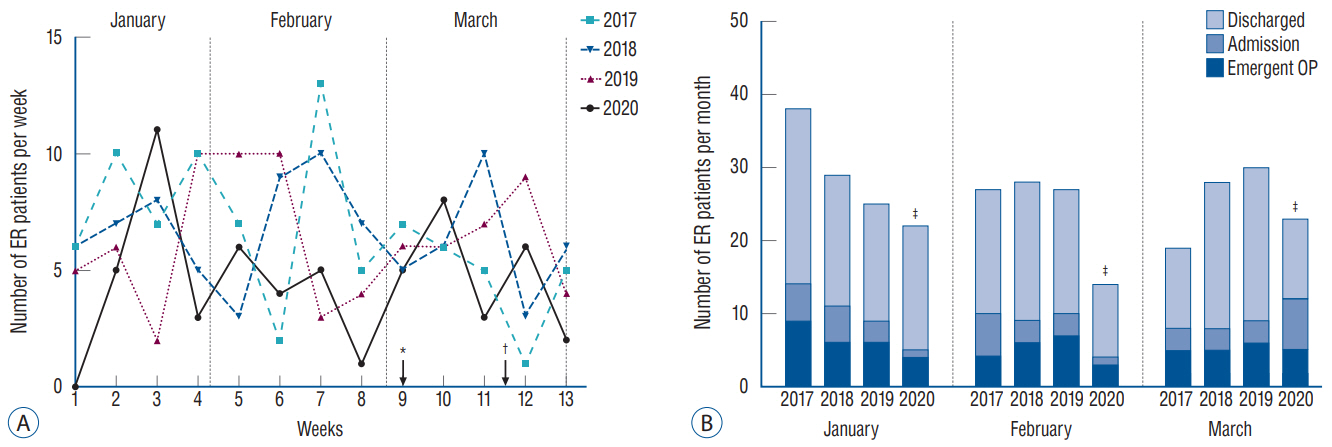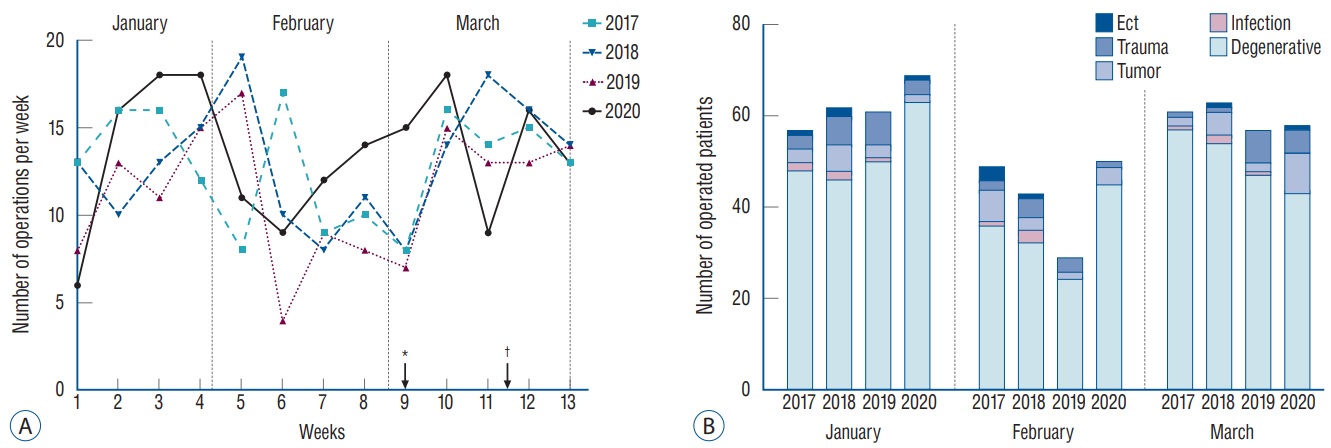J Korean Neurosurg Soc.
2020 Jul;63(4):407-414. 10.3340/jkns.2020.0114.
Coronavirus Disease (COVID-19) Outbreak and Its Impact on Spinal Daily Practice : Preliminary Report from a Single (Regional) University Hospital in Republic of Korea
- Affiliations
-
- 1Department of Neurosurgery, Korea University Guro Hospital, Korea University College of Medicine, Seoul, Korea
- 2Spine and Joint Center, 9988 Hospital, Seoul, Korea
- 3Focused Training Center for Trauma, Korea University Guro Hospital, Korea University College of Medicine, Seoul, Korea
- KMID: 2504634
- DOI: http://doi.org/10.3340/jkns.2020.0114
Abstract
Objective
: Since the first discovery of the 2019 novel coronavirus (COVID-19), rapid and wide spread of the disease has been reported and the World Health Organization announced that a ‘pandemic’ has started. Up to date there is little known regarding the impact of this outbreak on spinal specialists’ daily clinical practice. We intended to evaluate how COVID-19 has affected the number of spinal disease patients we meet and operate in daily practice.
Methods
: The de-identified data regarding number of patients visiting the spine clinic at a tertiary referral hospital and a secondary level hospital from January, February and March of 2017 to 2020 were retrospectively reviewed. The number of out-patient department (OPD) visits, number of emergency room (ER) visits as well as number of surgeries performed during the reviewed period were collected and analyzed, comparing 2020 to the previous 3 years.
Results
: The number of daily OPD visits showed a steady decrease starting from January, and presented a statistically significant decrease by early March 2020, compared to the previous 3 years. During the same period, decrease in number of daily ER visits was statistically significant as well. The number of elective surgeries or number of surgeries for patients admitted via ER during COVID-19 outbreak remained similar to that of 2017–2019 suggesting, despite the decrease of patients visiting the hospital for spinal diseases, those whom required surgery still visited the hospital. The results were consistant among other hospital level.
Conclusion
: The outbreak of COVID-19 affected our daily practice as OPD and ER visits reduced but did not affect the number of surgeries. We believe that this report will be informative to spinal specialists worldwide fighting the COVID-19 pandemic.
Keyword
Figure
Cited by 2 articles
-
Impact of the COVID-19 Outbreak on Emergency Care Utilization in Patients with Acute Myocardial Infarction: a Nationwide Population-based Study
Ho Kyung Sung, Jin Hui Paik, Yu Jin Lee, Soo Kang
J Korean Med Sci. 2021;36(16):e111. doi: 10.3346/jkms.2021.36.e111.Comparative Analysis of COVID-19 Outbreak and Changes in Neurosurgical Emergency Patients
Min Ho Lee, Seu-Ryang Jang, Tae-Kyu Lee
J Korean Neurosurg Soc. 2022;65(1):130-137. doi: 10.3340/jkns.2021.0056.
Reference
-
References
1. Carlos WG, Dela Cruz CS, Cao B, Pasnick S, Jamil S. Novel Wuhan (2019- nCoV) coronavirus. Am J Respir Crit Care Med. 201:P7–P8. 2020.2. Centers for Disease Control and Prevention. Disease 2019 (COVID-19): Cases in U.S. Available at : https://www.cdc.gov/coronavirus/2019-ncov/cases-updates/cases-in-us.html.3. Chu M, Jung YS. Coronavirus spread in South Korea surges to 763 cases and 7 deaths. Avaliable at : http://www.monews.co.kr/news/articleView.html?idxno=208524.4. Huang C, Wang Y, Li X, Ren L, Zhao J, Hu Y, et al. Clinical features of patients infected with 2019 novel coronavirus in Wuhan, China. Lancet. 395:497–506. 2020.
Article5. Huh S. How to train the health personnel for protecting themselves from novel coronavirus (COVID-19) infection during their patient or suspected case care. J Educ Eval Health Prof. 17:10. 2020.
Article6. Hursitoglu M, Erdal GS, Akdeniz E, Kocoglu H, Kocamaz N, Tevetoglu IO, et al. Early effect of the fear of terrorism on a hospital’s emergency department use and on the incidence of cardiovascular events: a Turkish multicenter study. Int J Health Plann Manage. 34:872–879. 2019.
Article7. Kim HJ, Ko JS, Kim TY; Scientific Committee of the Korean Society of Anesthesiologists. Recommendations for anesthesia in patients suspected of COVID-19 coronavirus infection. Korean J Anesthesiol. 73:89–91. 2020.
Article8. Kim JY, Choe PG, Oh Y, Oh KJ, Kim J, Park SJ, et al. The first case of 2019 novel coronavirus pneumonia imported into Korea from Wuhan, China: implication for infection prevention and control measures. J Korean Med Sci. 35:e61. 2020.
Article9. Ko SJ. Corona Virus at a spine and joint specialized hospital. Lessons from the case. Avaliable at : https://www.doctorsnews.co.kr/news/articleView.html?idxno=133217.10. Korean Society of Infectious Diseases; Korean Society of Pediatric Infectious Diseases; Korean Society of Epidemiology; Korean Society for Antimicrobial Therapy; Korean Society for Healthcare-associated Infection Control and Prevention; Korea Centers for Disease Control and Prevention. Report on the epidemiological features of Coronavirus disease 2019 (COVID-19) outbreak in the Republic of Korea from January 19 to March 2, 2020. J Korean Med Sci. 35:e112. 2020.11. Ministry of Health and Welfare. Daily update of coronavirus-19 cases in Korea. Avaliable at : http://ncov.mohw.go.kr/en.12. Ministry of Health and Welfare. Recommendations from KCDC. Avaliable at : http://ncov.mohw.go.kr/infoBoardList.do.13. Ren LL, Wang YM, Wu ZQ, Xiang ZC, Guo L, Xu T, et al. Identification of a novel coronavirus causing severe pneumonia in human: a descriptive study. Chin Med J (Engl). 133:1015–1024. 2020.
Article14. Rothan HA, Byrareddy SN. The epidemiology and pathogenesis of coronavirus disease (COVID-19) outbreak. J Autoimmun. 109:102433. 2020.
Article15. Wang W, Tang J, Wei F. Updated understanding of the outbreak of 2019 novel coronavirus (2019-nCoV) in Wuhan, China. J Med Virol. 92:441–447. 2020.
Article16. World Health Organization. Coronavirus disease (COVID-19) Pandemic. Available at : https://www.who.int/emergencies/diseases/novel-coronavirus-2019.17. Zhao S, Lin Q, Ran J, Musa SS, Yang G, Wang W, et al. Preliminary estimation of the basic reproduction number of novel coronavirus (2019-nCoV) in China, from 2019 to 2020: a data-driven analysis in the early phase of the outbreak. Int J Infect Dis. 92:214–217. 2020.
Article
- Full Text Links
- Actions
-
Cited
- CITED
-
- Close
- Share
- Similar articles
-
- Report on the Epidemiological Features of Coronavirus Disease 2019 (COVID-19) Outbreak in the Republic of Korea from January 19 to March 2, 2020
- Management of Traumatic Spinal Fracture in the Coronavirus Disease 2019 Situation
- Clinical and Epidemiological Characteristics of Coronavirus Disease 2019 in the Early Stage of Outbreak
- COVID-19 from the Perspective of a Gastroenterologist
- Experience of Treating Critically Ill COVID-19 Patients in Daegu, South Korea




